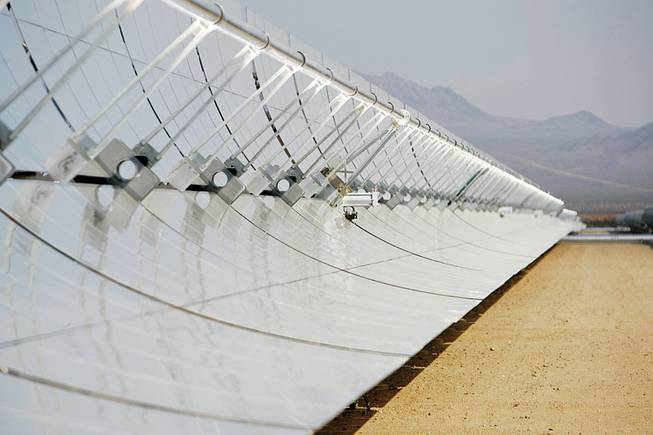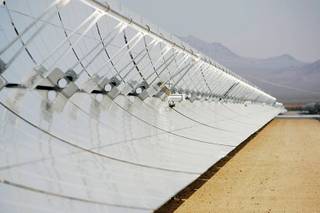
STEVE MARCUS / LAS VEGAS SUN FILE
Utility-scale solar, like this solar field that is part of the Nevada Solar One solar thermal power plant near Boulder City, got a big boost from Legislature.
Published Monday, June 15, 2009 | 2 a.m.
Updated Monday, June 15, 2009 | 9:38 a.m.
Green Energy Bills
Nevada lawmakers say the state is poised to become the nation's leader in green energy. In Business talks with Nevada Conservation League Executive Director Scot Rutledge. Plus, the valley's auto industry hits some economic speed bumps.

Marilyn Kirkpatrick
Sun Archives
- How we did: A look back at the session (6-7-2009)
- Obama here for the sunshine (5-28-2009)
- Bill would extend renewable tax credits (5-16-2009)
- If you want our sunshine, you may have to pay extra (3-24-2009)
- 'The Dynamic Duo' comes to Nevada's rescue (5-28-2007)
Sun Coverage
Beyond the Sun
Charged with reworking the state’s renewable energy policy, Assemblywoman Marilyn Kirkpatrick had one major objective as she entered the legislative session: Don’t give away the farm, er, the desert.
Kirkpatrick was criticized after the 2007 session for working to give lucrative tax breaks to casino companies in the guise of “green buildings.”
She didn’t want a repeat.
The North Las Vegas Democrat was operating in an environment that was at once friendlier and tougher than ever for renewable energy development.
The concept of moving away from fossil fuels and toward solar and geothermal developments emerged over the past two years as an economic salve. You only had to hear the words of President Obama nationally and Sen. Harry Reid locally: “Green jobs” would transform the country and bring it out of recession, they argued. With plentiful sun and plentiful land and proximity to a state with a voracious appetite for renewable energy, Nevada should benefit, they said.
But then came the state budget crisis.
Bigger-than-ever tax cuts for renewable energy companies would be a tough sell.
With the session now over and the state’s new energy policy in full view, it’s fair to ask: Just what was accomplished?
The answer is: quite a lot.
Observers say Nevada has made itself into the most attractive state in the sun-drenched West for large solar plant development. Utility-size solar generation plants in the desert, along with geothermal plants, got a big boost this session.
Jim Baak, director of utility-scale solar for the nonprofit advocacy group Vote Solar, said Nevada was far more proactive than other sunny-state legislatures this year. Texas called its legislative session the “Solar Session” but still wasn’t able to pass productive new laws, said Baak, who monitors solar issues in states. Florida became equally mired, he said.
If some other objectives are met, large-scale solar is likely to become the focus of renewable energy development in Nevada for at least the short term, observers say. That should bring thousands of construction jobs to the state with built-in wage requirements. Large-scale solar plants tend to operate without a lot of employees once they’re up and running.
Legislators had less to show in the way of providing incentives for homeowners and others to install rooftop solar devices and for the manufacturers of renewable energy equipment to build plants in Nevada. Both tend to have many permanent jobs associated with them.
Among moves made this session intended to spur renewable energy, legislators:
- Extended and increased the portion of Nevada energy that must come from renewable resources from 20 percent by 2015 to 25 percent by 2025. That ensures an expanding appetite for renewable energy in the state.
- Extended property tax abatements for renewable energy production plants, which were to expire in this year, and expanded them from 50 percent for 10 years to 55 percent for 20 years.
- Allowed geothermal power plants to receive property tax abatements.
- Created a renewable energy commission and transferred many of the duties of the governor’s energy office to that body.
- Expanded the program that offers rebates for households and businesses that put solar panels on their rooftops and made changes in how the program is to be operated.
Rose McKinney-James, a longtime solar energy advocate in Nevada who lobbied for rooftop solar companies this session, had hoped to enhance the incentives to install rooftop photovoltaic panels and other forms of so-called distributed energy generation. But the state’s main utility, NV Energy, fought back and said that a new requirement could cost ratepayers — and the company — too much.
“We were having this discussion at a very difficult time,” McKinney-James said. “Everybody recognized that they faced some very significant challenges, and within that context I think that we achieved a great deal.”
Although she mostly lost that battle, McKinney-James said she hopes changes in the operation of the rebate program will make it easier for people to sign up. She said she believes that expansion of the rebates legislators did approve will create more rooftop solar setups in the state.
McKinney-James gave the session a just-decent rating, but large-scale solar developers were much more enthusiastic.
The developers had started the session worried about a fierce stance by Assemblywoman Kirkpatrick, who began the year saying she would not support the industry’s request for a 75 percent property tax abatement and would impose a new tax on renewable energy. The revenue would go to offset higher energy costs for ratepayers.
Kirkpatrick was concerned that solar plants would not bring many permanent jobs to Nevada, and that solar plant construction jobs have gone to out-of-state workers in the past.
But the possibility of a new tax “brought development to a halt,” said renewable energy lobbyist Tom Clark. “It sent a red flag to every developer.”
Developers pleaded with Kirkpatrick and presented studies showing that the state would still receive significant economic benefits from solar plants without a separate tax.
Such a tax would kill the industry in Nevada, they warned. Developers would turn to other states.
The argument worked.
Kirkpatrick stayed up almost the whole night before the final day bills were due, putting the finishing touches on her legislation. She showed up at her committee the next day at the last possible second, her hair disheveled, stumbling slightly over her words.
The new version included no additional tax. Instead, Kirkpatrick wrote in requirements for employers to pay at least a certain wage and added that some property taxes paid by solar plants would go into a state fund to offset rising costs for utility ratepayers.
Most notably, the new renewable energy commission, created in a Senate bill, would decide whether the financial benefits of a new solar power plant to the state outweigh the tax abatements before it approves abatements.
“If you look previously at the exemptions, there wasn’t a lot of accountability to the public,” Kirkpatrick said. “It’s great to build up solar stuff, but for me it’s purely an economic analysis.”
Solar developers say they’re happy with the compromise, but some of their advocates are troubled about the role of the commission and its control over property tax abatements.
“That uncertainty causes some concern with project financing,” Baak, of Vote Solar, said.
Legislators passed the bill after a flurry of last-minute revisions to give counties the final say over whether geothermal developers are given tax abatements. Geothermal development is occurring mostly in Northern Nevada and rural legislators were reluctant to give up the tax revenue.
The next battlefront for developers eyeing Nevada is with the federal government to free up Bureau of Land Management land for solar development and to speed up the development of transmission lines to make it easier to transport energy into California.
The state’s main utility, NV Energy, also got a big win through a last-minute provision introduced into legislation to allow it to collect some of the savings ratepayers enjoy from conservation. It was a controversial measure that passed with very little public discussion.
Ratepayers will take a big hit with that, their advocates insist. Former consumer advocate Timothy Hay says depending on how it’s enforced by the Public Utilities Commission, the provision could cost ratepayers anywhere from millions to hundreds of millions of dollars.
NV Energy maintains that if that hadn’t passed, it would have had to cut back on its conservation program because the state isn’t growing as fast as it was.


Join the Discussion:
Check this out for a full explanation of our conversion to the LiveFyre commenting system and instructions on how to sign up for an account.
Full comments policy